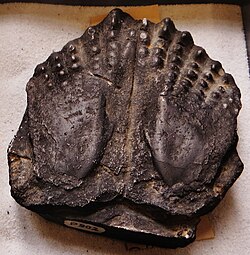| Chirodipterus Temporal range: | |
|---|---|
 | |
| Specimen of "C." australis | |
| Scientific classification | |
| Kingdom: | Animalia |
| Phylum: | Chordata |
| Class: | Dipnoi |
| Family: | † Chirodipteridae |
| Genus: | † Chirodipterus Gross, 1933 |
| Type species | |
| †Chirodipterus wildungensis Gross, 1933 | |
| Species | |
See text | |
Chirodipterus is an extinct genus of marine lungfish which lived during the Devonian period. [1] Fossils have been found worldwide, including Germany, China, eastern & western Australia, and the United States (Michigan). However, it has been suggested that the genus as currently defined is polyphyletic, in which case only the German type species (C. wildungensis) would belong to the genus. [2] [3]
The following species are known:
- †'C.'australisMiles, 1977 - Frasnian of Western Australia (Gogo Formation) [4]
- †'C.'liangchengiSong & Chang, 1991 - Late Devonian of Hunan, China
- †'C.'onawayensis Schultze, 1982 - Givetian of Michigan, USA (Traverse Group) [5]
- †'C.'potteri Kemp, 2000 - Frasnian and Famennian of New South Wales, Australia [6]
- †'C.'rhenanusMors, 1991 - Givetian of the Rhenish Massif, Germany [7]
- †C. wildungensis Gross, 1933 - Late Devonian of Wildungen, Germany


The former species C. paddyensis is now placed in the genus Gogodipterus . [8] It has been suggested that the type species (C. wildungensis), is most closely related to Rhinodipterus , whereas 'C.' australis and 'C.' liangchengi are related to Pillararhynchus and Sorbitorhynchus . [2]

